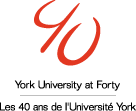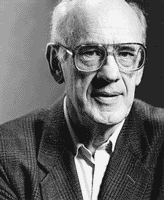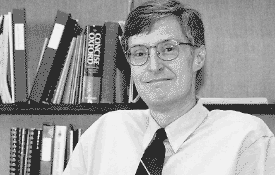
|

|
|
|
|
| | VOLUME 29, NUMBER 21 | WEDNESDAY, MARCH 3, 1999 | ISSN 1199-5246 | | |
|
|
||||
|
|
| |||
|
|
Professor Emeritus of Psychology Ian Howard
Perhaps it's no surprise that human beings want to get upright after spending nine blissful months floating upside down in their mother's womb. On the other hand, maybe not. Of course, even as babies much of our early lives are spent on our backs trying to make sense of that world 'above us' and, cognitively, trying to figure out what's up. By adulthood we've pretty much got it down pat until someone changes the rules. For instance, what happens when you put adults who are visually oriented to Earth's environment (where up is "up", and down "down") into space? Suddenly, chugging along in orbit, we humans have to make sense of a world where up, down and sideways are interchangeable and purely relative. How can we make decisions about where we are in reference to what we commonly consider as our sense of the "vertical" or "horizontal," and what happens when we can't? (Answer: "space sickness" among other things.) Many of these questions are central to Professor Emeritus of Psychology Ian Howard's research. Howard, who is director of York's Centre for Vision Research was on hand last month as part of the 1998-99 Research Lecture Series to give a talk on "Knowing which way is `up' on Earth and in Space." Howard tackled some of these fundamental (but extremely complex) questions and tried to explain them to scientists and non-scientists alike who constituted the Harry Crowe Room's audience at Atkinson College. According to Howard, most objects in our gravitational world here on Earth are visually "polarized" that is, our eyes receive clues telling us what's the top and what's the bottom of the object in question. The way light falls on an object, for instance, can provide visual orientation, since shadows tell us about an object in space (light comes from above, thus a ball's "top" might be lighter than the part in shadow which we take to be its "bottom"). There are also "extrinsic" clues that rely on the relation between two objects. A ball suspended on a string is an example. The extrinsic polarity between the two things tells us up from down (at least in our gravitational world). Because of gravity we know the ball will fall to the ground if released. But what would happen if you could create a room where the visual frame could be altered so that a subject in a room could be fooled into confusing up with down? NASA wanted to know something about this very question, says Howard. "They had a very expensive simulator at the cost of many millions of dollars," noted Howard. The results, however, were less than satisfactory. So NASA asked Howard, and his Human Performance Laboratory at the Centre for Research in Earth and Space Technology, if he could help. The idea he came up with was a room that tilts and rotates at a cost of a few thousand dollars. The room is used to measure the conflicts between visual input (say, if things look upside down) and the physical sensations caused by gravity (your inner ear mechanism, for instance) which tells you that you are still sitting vertical even though your eyes are telling your brain you should be falling out of the chair you are strapped into. Howard's "rotating room" is not unlike a kitchen at home. There is a table and chairs, wallpaper, cups "hanging" from hooks, a window (with fake background), pictures on the walls, plates and placemats on the table and even curtains. In other words, everything needed to tell you you are in a perfectly normal room. Of course the plates are glued to the table, the table screwed to the floor and the pictures anchored to the wall, so that even if the room is turned upside down everything appears to defy gravity (even the curtains, artificially stiffened, to stay "right side" up). Subjects are strapped into a chair which can also be rotated and moved in relation to the room to provide researchers with a variety of experimental scenarios. All this research is important in order to find out how micro gravity conditions (in space) affect human health and performance on long-term space missions. With the era of more space stations beginning, the issues are real ones. While scientists know a little about the effects of lengthy weightlessness, there is still much that is unknown. Another issue is how an astronaut's body will re-adapt to gravity after prolonged bouts in a micro gravity environment. Howard's room has produced some interesting findings. For instance, if you're LYING DOWN flat on your back, and Howard tilts his room so that the artificial "up" is in line with how you are lying (you and the room are "visually oriented") you will actually feel as if you are perfectly upright! Howard says 50 per cent of the adults they tested experienced this sensation known as the "levitation illusion". "People of all ages use visual motion to control body posture," says Howard. "And all those visual cues have to be learned. And how we process information about the orientation of the world around us varies with age. Toddlers, for instance, are more disturbed by changes in a visual scene than adults. If a background appears to sway, toddlers will fall down, but adults won't." Insights into how humans perceive their world through experiments conducted by Howard in his tilting room and in other visual environments with which he experiments, will be useful in a number of ways, he says. "We can use what we learn here on earth to test the 'presence' of virtual reality scenes for things like flight simulators. We can learn how to make things seem more real. We can also learn things about how to design visual environments for 'stability' that might aid in counteracting things like space sickness. Some of our results will have applications in pre-flight training for astronauts, that is, inducing feelings of weightlessness so that they get used to working in those kinds of environments. The work we do may even have applications for the elderly. For instance, the elderly often stumble on stairs that are at a 45 degree angle if the walls have no visuals [that they can use to orient themselves]. The question is, can we make all these environments, whether in space or here on Earth, better?"
|
|||
|
|
Following the appointment of Professor Stan Shapson as associate vice-president (Strategic Academic Initiatives) in the Office of the Vice-President (Academic Affairs) and Provost, President Marsden has struck a committee to search for a new dean of the Faculty of Education. Professor Jill Bell has agreed to serve as acting dean during the search process. Chaired by Vice-President Michael Stevenson, the search committee comprises the following members: Ms Nora Allingham (seconded faculty member, Faculty of Education), Professor Michael Brown (Faculty of Arts), Ms Brenda Corrigan-Elliott (Faculty of Education alumnae), Ms Jenn Covent (undergraduate Education student), Professor Don Dippo (Faculty of Education), Mr. John Ippolito (graduate Education student), Professor Neita Israelite (Faculty of Education), Ms Bev Merriman (administrative officer, Faculty of Education), and Ms Marla Chodak (secretary). The Committee welcomes comments, applications, and nominations from the York community, by its deadline date of March 30, 1999; and may be contacted through its secretary in Room S935 Ross Building or via e-mail, mchodak@yorku.ca. |
|||
|
|
By Beverley Else
York University has received an honourable mention for excellence in internationalization from the Association of Universities and Colleges of Canada (AUCC) and Scotiabank for its approach to international student recruitment. In 1996 York decided that recruitment of international students was a crucial component of its internationalization strategy. A decision was made to create the Office of International Student Recruitment and Admissions as a distinct unit within the Office of Admissions. This decision came at a time when York, like other universities, was faced with significant cutbacks in government funding, with little of no resources available for new initiatives and support services. "By adopting a 'Team York' approach," said Deborah Hobson, vice-president (Enrolment & Student Services), "York was able to overcome these limitations by drawing on the contributions of faculty, students, alumni and staff. Through discussions in the International Action Group we have been able to think creatively and share ideas about special initiatives and packaging of current course offerings to meet the needs of specific client groups abroad." Hobson explained that York has also been successful in developing a better understanding of the educational systems in certain markets such as India and Pakistan. This has led to a revision of admissions policies for these countries without sacrificing the quality of the applicants, and has resulted in a 42 per cent increase in international student enrolments over the past two years. "We are very pleased with this acknowledgement of our success from Scotiabank and the AUCC", she said. Next fall, for the first time, the University will be able to offer international students the opportunity of spending "a Canadian year abroad" through its Visiting Student program, by packaging existing courses in specially-designed theme areas such as Women's Studies and Canadian Studies. Launched in 1997, the Scotiabank-AUCC awards for excellence recognize Canadian universities' achievements in bringing an international perspective into the teaching, research and service functions of their campuses, and to promote awareness of innovative practices being used by the university community. |
|||
|
|
Michael Mouritsen, happy to be back at York. Michael Mouritsen is no stranger to York. He has fond memories of his student days (BA History '74) where he was active in University governance, serving on the Senate, as first and only student Chair of the Faculty of Arts Council, and as president of the York Student Federation. He also worked at York from 1974 to 1978 for then-Vice-President Bill Farr (Employee & Student Relations) with whom he worked on both labour negotiations and as convocation officer. In Feb. 1999 Mouritsen returned as Administrative Director and Assistant Secretary in the Office of the University Secretary and General Counsel. Since leaving York, Mouritsen has held progressively senior administrative positions at the Clarke Institute of Psychiatry, the University of Toronto, and for the last 12 years, the Ministry of Education and Training where he held the position of Senior Policy Advisor for the Universities Branch. For two years he was on secondment from the ministry as Secretary to AMAPCEO, the province-wide bargaining agent for professional and managerial civil servants who work for the Ontario government.. "It feels good to be back," Mouritsen told the Gazette. "I was here before the major building programs began. It's exciting to see all the changes, to re-introduce myself to old colleagues and meet new ones." "Michael's knowledge of University issues, his years of experience as a senior administrator and his familiarity with York will undoubtedly be a huge assset to the University," said University Secretary and General Counsel Harriet Lewis. "He is joining a team of very dedicated professionals and we are pleased to have him. I hope everyone will welcome him back to the University and wish him well in his position." Mouritsen himself has a very positive view of his return to York. "Perhaps you need some distance from a place before you can see its real strengths," he said. "The strengths of York have become clearer over the years: its diversity, its strong sense of community and its commitment to staff, students and faculty."
|
|||
|
|
On November 24, 1998, the University Complaint Centre in the Office of Student Affairs received a serious complaint against MacMedia, the newspaper of the McLaughlin College Council, and its editor. The complaint, made pursuant to Presidential Regulations 2 and 3 governing student conduct, concerned specific articles in MacMedia's October and November 1998 issues. While the University Complaint Centre was still in the process of trying to resolve the complaint, it received additional complaints, counter-complaints and letters during the months of December 1998, and January and February 1999. It is apparent to me that several articles published in the October, November and December issues of MacMedia were hurtful, offensive and sexist in nature. All the principal parties involved in the complaint process share this assessment. The University does not condone such threats to the well-being of the York community. Since receipt of the complaints, the Office of Student Affairs has involved the complainants and the respondents in a facilitated complaint resolution process so that they could identify fully the redress deemed appropriate and work cooperatively towards achieving a resolution satisfactory to the York community. To date this process has resulted in two outcomes agreed to by the complainants and the respondents:
A further outcome that is now being explored is an educational program that would consist of a series of media workshops to complement the annual Spring Transitional Conference for representatives of student governments, campus media and student organizations. Such workshops would be repeated throughout the year to allow all members of the campus media to attend. The primary focus of such workshops would be to gain an understanding of issues involving the proper treatment of gender, sexual identity, sexism, sexual harassment, race and racial discrimination. Campus media would develop guidelines and standards of conduct that would ensure an open, tolerant and non-threatening environment in which to learn and work, while at the same time maintaining academic freedom and freedom of the press in our community. I am hopeful that those involved in the complaints will continue to engage in the facilitated resolution process. Michael Stevenson
|
|||
|
|
By Paul Delaney Space Mirrors
If all had gone according to plan, a 25-metre diameter mirror would have been deployed from the Russian Mir space station on Feb.4, 1999. This would have resulted in a bright beam of light being directed towards the surface of the Earth, visible to many cities in Canada. The aim of this engineering test was to ascertain the feasibility of deploying such a thin mylar sheet to divert sunlight to dark regions of northern Russia. Ultimately, a string of such mirrors could be used to lighten up large tracts of land in the depths of winter, alleviating the dreary long winter's nights. However, during deployment, the thin, flimsy material became snagged on various antennae and the result was the loss of the experiment. Normally, I would be in favour of any space-based endeavor and the loss of an experiment would be a great disappointment. However, in this instance, I am rather glad of the failure and would dearly hope that such a deployment never is attempted again. While I grant the notion involves neat technology and that if that technology is put to use in the form of solar sailing or the like, I would be happy to see such activity repeated. The space mirror, called Znamya, represents a threat to the night sky for amateur and professional astronomers alike and that disturbs me. Astronomers have worked hard in recent years to protect the night sky from many forms of electromagnetic pollution. Radio waves and stray light both threaten research and degrade the pleasure many people gain from observing the celestial sphere. The concept of trying to bring back the sun at night seems bizarre. There are all too few truly dark skies left on the planet and much research is done from these locations. Some of the most intense amateur astronomy is conducted in these out of the way locations. Many people strive to go where civilization is not. Imagine your own piece of wilderness, peaceful and tranquil, shattered by the daunting array of many mock suns in the midnight sky. Quite apart from the tastelessness of it all, it may even be dangerous. A quick calculation shows that reflecting that much sunlight off a highly reflective surface of 25 metres only a few hundred kilometers above the surface of the Earth, may pose a serious danger to your eyes in a matter of seconds. We certainly do not encourage staring at the Sun during the day so why should a mirror reflecting unfiltered sunlight be any safer. It is a debatable point at the moment but I for one do not plan to watch any such mirror deployment. The Znamya project is not likely dead yet but I see little use for this exercise in its current form. The human cycle of day and night has evolved over countless generations and we have all adapted to it very successfully. Keep lights on the ground and not in space and let us all continue to enjoy the night sky (as best we can!). March Sky
So, what is up in the sky this month? Well to begin with, we will again have two full moons, on March 2 and March 31. There were two full moons in January and none in February! New moon is on March 17. Indeed, the Moon will be passing close to several objects throughout this month. Of particular note is the close proximity of Regulus (brightest star in Leo) to the Moon on March 2 and 28, the close approach of Venus and Saturn to the Moon on March 20 and the proximity of Aldebaran (brightest star in Taurus) on March 22. The beginning of spring will take place at 8:46 p.m. local time of March 20. We will lose sight of Jupiter around the middle of the month in the bright evening twilight. Saturn is observable in the southwest but it too is getting low. To compensate, Venus is rising steadily higher in the west and is a brilliant point of light. Public viewing at the York University Observatory continues throughout March from 6:30 p.m. until 8:30 p.m. Wednesday evenings. For information, telephone (416) 736-2100 extension 77773. Paul Delaney is an Associate Lecturer in physics & astronomy, and Master of Bethune College.
Special thanks to Mel Blake, doctoral student in physics and astronomy, for this representation of the March night sky.
|
|||
|
|
|
| ||
| | Current Issue | Previous Month | Past Issues | Rate Card | Contact Information | Search | |




